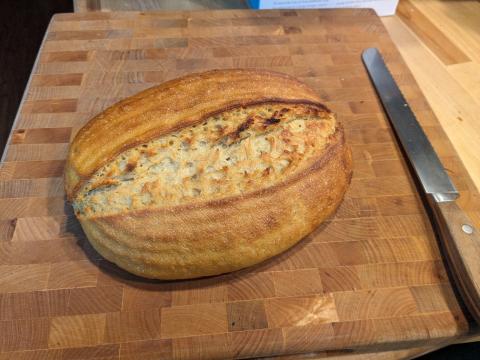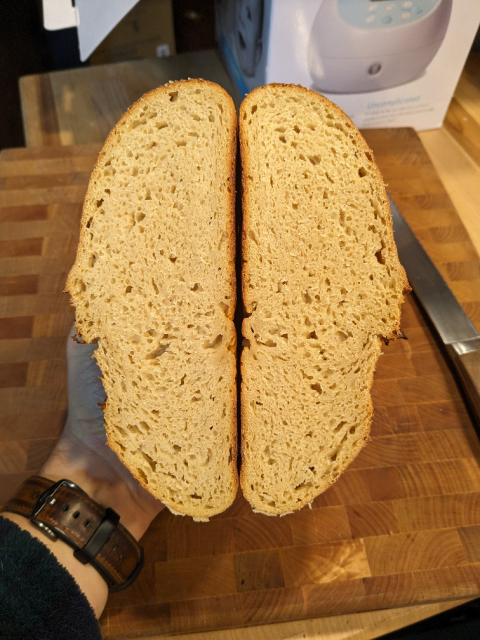
The Quest for Home Milled Semola Rimacinata, part 1
Inspired by Will's Altamura and Matera bakes made with 100% semola rimacinata, I wanted to try a durum loaf again. A couple of years ago I acquired a 50lb bag of durum berries from Central Milling while I was up in Logan visiting family, so I wanted to see if I could replicate his results with freshly ground flour.
I have Komo Mio stone mill and a 40 mesh sieve from Breadtopia (I bought the combo with a 50 mesh sieve but that one got ruined trying to drain some overwatered rice last year), so I started sifting out most of the bran and the largest endosperm particles after one pass at the finest setting. I tried to do the gentle mixing Will mentioned, but my mixer is a KitchenAid, and by the time the 65% water was incorporated and I let it fermentolyse, the dough already felt pretty developed. I increased hydration to 70%, but even though the dough felt soft and extensible, by the time it finished bulk ferment the top was all split.
I don't have a picture of the first loaf I made, but it was very small and the crumb was very close, nothing like what I've seen from semola remacinata.
For my second bake I bought another 50 mesh sieve off Amazon to try to get a lower extraction of finer flour. I experimented with starting coarse and regrinding the retentate, but the flour had less bran when I did one pass at the finest setting (one click before the stones touch) and didn't regrind anything. This time I hand mixed, starting at 75% hydration and ending up at 85% when I felt like the dough had the right consistency. Once again the dough felt very good, soft and extensible, but cracked during bulk ferment and proof. The resulting loaf was better than the first, but still nowhere near where I'd like it to be.
The extraction rate was much higher with the 50 mesh than I expected, about 87%. The old Breadtopia sieve I had would get closer to 50%, so maybe I need to get another sieve at 60 mesh to really get that fine flour.
My current baking schedule uses 3-5% prefermented flour (stiff starter) and a 12-14 hour room temperature bulk ferment, then a 8-10 hour retarded proof. My next step in the project is to see if the durum just doesn't handle long fermentation as well as hard red or white wheat, so I'll do a higher preferment and shorter bulk ferment to see if I get less breakdown. I'm also going to try tempering the durum to see if that helps grind it finer. If neither of those work I'm investing in a 60 mesh sieve and using whatever doesn't go through as semolina for peel dusting and/or fresh pasta.





Comments
I think that honest-to-goodness DOP Altamura bread uses a mix of several different grades of durum: remacinata, semnila, and I don't know about other grades. I have made a pretty decent version using a combination of extra fancy durum and a semolina package that I have (I think it was from Hayden Mills, but I'm not completely sure)
I have made a ton of different original bakes using my own fresh milled Durum using my MockMill200 which is similar to your Komo. I find no reason to go to a #50 to get a good consistent fine flour to use. My method is as follows: I mill on a setting right before the stones start clicking for the first pass. I sift out the larger bran using a #30 Sieve. I then re-mill using the finest setting with the stones just touching and sift with a #40. I find this provides the perfect flour for baking bread. Here is one of my recent bakes which was close to a 100% durum bake with some additional add ins. If you search Durum on my blog you will find a bunch of bakes for inspiration.
https://mookielovesbread.wordpress.com/2022/08/13/100-durum-with-harvest-grains/